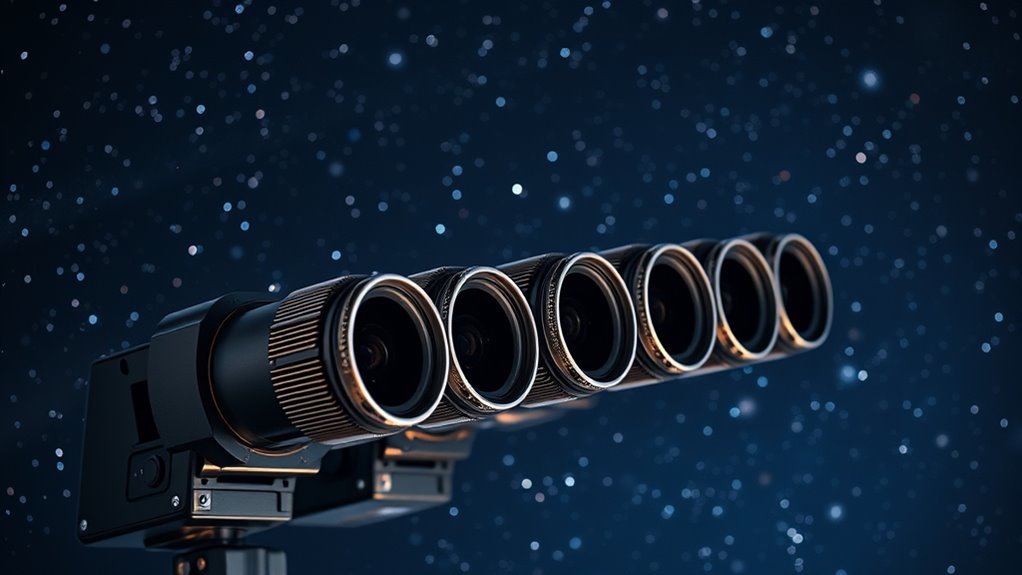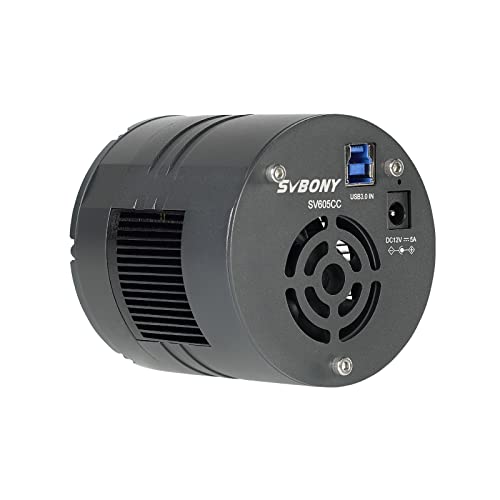Based on recent reviews, the top cooled CMOS astro cameras for deep sky imaging in 2025 are the SVBONY SV605CC and the Astromania SGCMOS series. Both feature high sensitivity sensors, efficient cooling, and excellent resolution, making them ideal for capturing faint celestial objects. The SV605CC offers robust software support and portability, while the Astromania provides impressive image quality with versatile connectivity. If you continue exploring, you’ll discover in-depth comparisons that can help you choose the perfect camera for your astrophotos.
Key Takeaways
- High-sensitivity sensors like the IMX533 with up to 80% quantum efficiency deliver exceptional low-light performance for deep sky imaging.
- Advanced cooling technologies, including double-layer TEC cooling, effectively reduce thermal noise and residual glow during long exposures.
- Compatibility with USB 3.0, ASCOM, and SDKs ensures seamless integration and software flexibility for astrophotography workflows.
- High-resolution sensors (e.g., 3008×3008 pixels) and small pixel sizes (3.76μm) enable capturing fine details of nebulae, galaxies, and star clusters.
- Compact, durable designs with quick cooling cycles and stable temperature control maximize imaging efficiency in field conditions.
SVBONY SV605CC Cooled Astrophotography Camera
The SVBONY SV605CC cooled astrophotography camera is an excellent choice for serious astronomers who want high-quality images of deep sky objects. It features a 1-inch IMX533 color sensor with 3008×3008 resolution and 9MP, capturing fine details with 3.76μm pixels. Its 80% quantum efficiency boosts imaging efficiency, while glow suppression technology reduces residual glow and improves the signal-to-noise ratio. The double-layer semiconductor refrigeration cools the sensor to 30°C below ambient, minimizing thermal noise. Equipped with USB 3.0, it ensures fast data transfer for efficient image capture. Perfect for deep sky, panoramic, and meteor imaging, it’s a versatile tool.
Best For: serious amateur and professional astronomers seeking high-resolution, low-noise deep sky imaging with fast data transfer capabilities.
Pros:
- High-resolution 1-inch IMX533 sensor with 3008×3008 pixels and 9MP for detailed imaging
- 80% quantum efficiency for improved light capture and imaging efficiency
- Efficient cooling system reduces thermal noise, resulting in clearer images
Cons:
- May require additional accessories or mounts for optimal operation
- Potentially higher cost compared to entry-level astrophotography cameras
- Requires a stable power source and proper setup for cooling performance
Astromania SGCMOS Series Telescope CMOS Camera
If you’re serious about astrophotography or auto-guiding, the Astromania SGCMOS Series Telescope CMOS Camera offers an excellent solution with its high-sensitivity sensor and fast frame rate. It supports multicolor imaging, video preview, and RAW data output, making it versatile for various imaging needs. The built-in ST4 auto-guiding port simplifies setup, while the 1.25-inch nosepiece allows precise focusing and filter installation. Its aluminum CNC housing ensures durability and efficient heat dissipation. Compatibility with Native, ASCOM, and WDM drivers guarantees seamless integration with your existing software. Overall, it’s a reliable, compact choice for deep sky imaging and auto-guiding.
Best For: Amateur and professional astronomers seeking a versatile, high-sensitivity CMOS camera for astrophotography and auto-guiding.
Pros:
- High sensitivity sensor with fast frame rate and long exposure capabilities for detailed imaging.
- Supports multicolor imaging, video preview, recording, and raw data output for versatile use.
- Built-in ST4 auto-guiding port and compatibility with Native/ASCOM/WDM drivers for seamless integration.
Cons:
- Aluminum CNC housing may be heavier compared to plastic models, potentially affecting portability.
- Requires additional accessories like filters and third-party software for full capabilities.
- Limited to USB 2.0 interface, which may be slower than newer USB standards for high-volume data transfer.
Factors to Consider When Choosing Cooled CMOS Astro Cameras for Deep Sky Imaging

When selecting a cooled CMOS astro camera for deep sky imaging, I focus on factors like sensor sensitivity, cooling efficiency, and image resolution to make certain I get clear, detailed shots. I also consider how easy it is to connect and operate the camera with my existing setup, along with its portability. By weighing these points carefully, I can choose a camera that meets my imaging needs and setup preferences effectively.
Sensor Sensitivity and Efficiency
Ever wondered what makes a cooled CMOS astro camera excel in capturing faint deep-sky objects? It all comes down to sensor sensitivity and efficiency. Quantum efficiency plays a key role here, indicating how effectively the sensor converts incoming photons into electrical signals. Higher values, like up to 80%, mean better performance in low-light conditions, allowing you to capture more detail from dim objects. Pixel size also matters; around 3.7μm pixels influence how much light the sensor gathers, impacting overall sensitivity. Cooling the sensor further enhances this by reducing thermal noise, enabling longer exposures without signal loss. Additionally, residual glow suppression technology minimizes background noise, improving the signal-to-noise ratio. Altogether, these factors determine how well your camera can detect faint signals from the depths of the universe.
Cooling Performance and Noise Reduction
To achieve ideal deep sky images, effective cooling performance is essential because it directly impacts the sensor’s thermal noise and overall image quality. Good cooling lowers the sensor temperature by at least 30°C below ambient, drastically reducing thermal noise. Technologies like double-layer semiconductor refrigeration with TEC secondary cooling boost performance and keep the temperature stable. This stability is fundamental for long exposures, as fluctuations can cause noise artifacts. Lower sensor temperatures improve the signal-to-noise ratio, making faint details in deep sky objects stand out more clearly. Proper thermal management also minimizes residual glow and hot pixels, common noise sources in astrophotography. Overall, reliable cooling ensures consistently high-quality images, making it a critical factor when choosing a cooled CMOS astro camera.
Image Resolution and Pixel Size
Choosing the right image resolution and pixel size is key to capturing detailed deep sky images with a cooled CMOS astro camera. Higher resolution sensors with more pixels enable you to capture finer details of nebulae, galaxies, and star clusters. Smaller pixel sizes, like 3.76μm, offer higher image resolution but demand precise tracking to avoid star trailing. Conversely, larger pixels, such as 9μm, are more sensitive in low-light conditions, which benefits faint object imaging, but may reduce overall resolution. The balance between pixel size and resolution directly affects your camera’s ability to resolve fine details. Ultimately, selecting the ideal combination depends on your target objects and your telescope’s focal length, ensuring you get sharp, detailed images without sacrificing sensitivity.
Connectivity and Software Compatibility
Selecting a cooled CMOS astro camera with reliable connectivity is vital for smooth data transfer and efficient imaging sessions. I look for cameras supporting standard interfaces like USB 3.0, USB 2.0, or Ethernet to guarantee fast, stable data flow. Compatibility with popular astrophotography software platforms such as ASCOM, WDM, or native drivers is essential for seamless operation. I also verify that the camera’s drivers work across my operating system—Windows, Mac, or Linux—to prevent integration issues. Features like live preview, dark frame calibration, and raw data output provide flexibility during imaging. Additionally, SDKs or APIs are valuable for custom software integration or automation, especially when building advanced imaging or guiding setups. These factors help streamline my workflow and improve imaging results.
Portability and Setup Ease
When I’m setting up my deep sky imaging gear in the field, portability and ease of setup become top priorities. I look for cameras with compact, lightweight designs that are easy to carry and set up in various locations. Many models use USB 3.0 or USB 2.0 interfaces, which allow quick, hassle-free connections to my laptop or field computer. Simplified cooling systems, like single or double-layer thermoelectric cooling, make setup straightforward while still reducing thermal noise effectively. Compatibility with standard telescope adapters and focusers ensures seamless integration without extensive adjustments. Plus, user-friendly software and plug-and-play connectivity mean I can get everything up and running quickly, minimizing technical challenges and maximizing my imaging time in the field.
Frequently Asked Questions
How Do Cooled CMOS Cameras Compare to CCD Cameras for Deep Sky Imaging?
Cooled CMOS cameras often outperform CCDs in deep sky imaging because they offer faster readouts and lower noise levels, making it easier to capture faint details. While CCDs traditionally had better sensitivity, modern cooled CMOS sensors now provide comparable or superior performance with more convenience and affordability. I find that CMOS cameras are increasingly popular for astrophotography due to their versatility and improved image quality.
What Is the Typical Lifespan of Cooled CMOS Sensors in Astrophotography?
Think of a cooled CMOS sensor like a seasoned traveler—robust and built to last. Typically, it can serve well for 5 to 10 years, depending on usage and care. Proper maintenance, like avoiding extreme temperatures and handling it carefully, extends its journey. I’ve found that with careful use, my sensor remains reliable, capturing stunning deep-sky images well beyond its initial years, making it a worthwhile investment for serious astrophotographers.
Are Cooled CMOS Cameras Suitable for Planetary Imaging as Well?
Yes, cooled CMOS cameras work well for planetary imaging too. Their fast readouts and high frame rates help capture detailed, sharp images of planets. Cooling reduces noise, enhancing image quality during short exposures. I’ve found that modern cooled CMOS cameras offer excellent versatility, making them suitable for both deep sky and planetary photography. If you’re after clear, detailed planetary shots, a cooled CMOS camera is definitely worth considering.
How Does Ambient Temperature Affect Cooled CMOS Camera Performance?
Ambient temperature acts like an uninvited guest at my stargazing sessions, impacting my cooled CMOS camera’s performance. When it’s warm outside, the camera struggles more to maintain low temperatures, leading to increased noise and reduced image quality. Cooler nights help my camera work at its best, capturing clearer, more detailed images. So, I always try to observe during chilly evenings to get the most out of my equipment.
What Maintenance Is Required for Optimal Cooled CMOS Camera Operation?
To keep my cooled CMOS camera performing at its best, I regularly clean the sensor and lens with proper tools, guaranteeing no dust or debris interfere with image quality. I also inspect and maintain the cooling system, checking for proper operation and cooling efficiency. Additionally, I update firmware when needed and store the camera in a dry, dust-free environment to prevent damage and ensure longevity.
Conclusion
In the end, choosing the right cooled CMOS astro camera feels a bit like finding the perfect telescope—it’s about what subtly guides your passion and patience. Both the SVBONY SV605CC and the Astromania SGCMOS offer promising pathways through the dark skies, each with their gentle strengths. Trust your instincts, consider your unique needs, and remember, sometimes the quietest tools reveal the most breathtaking vistas. Your celestial journey awaits—happy imaging!













